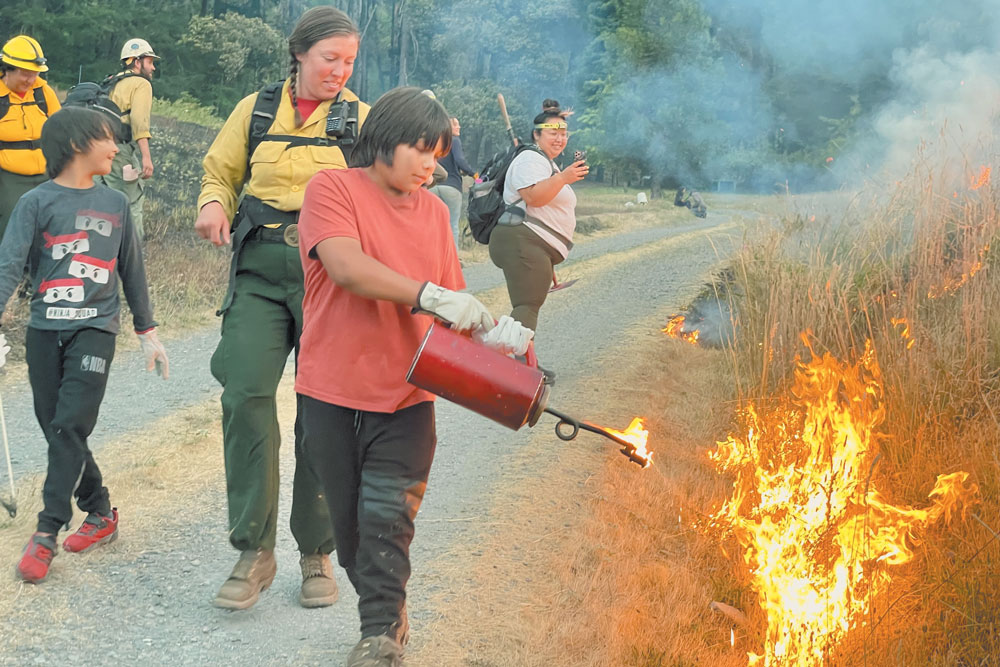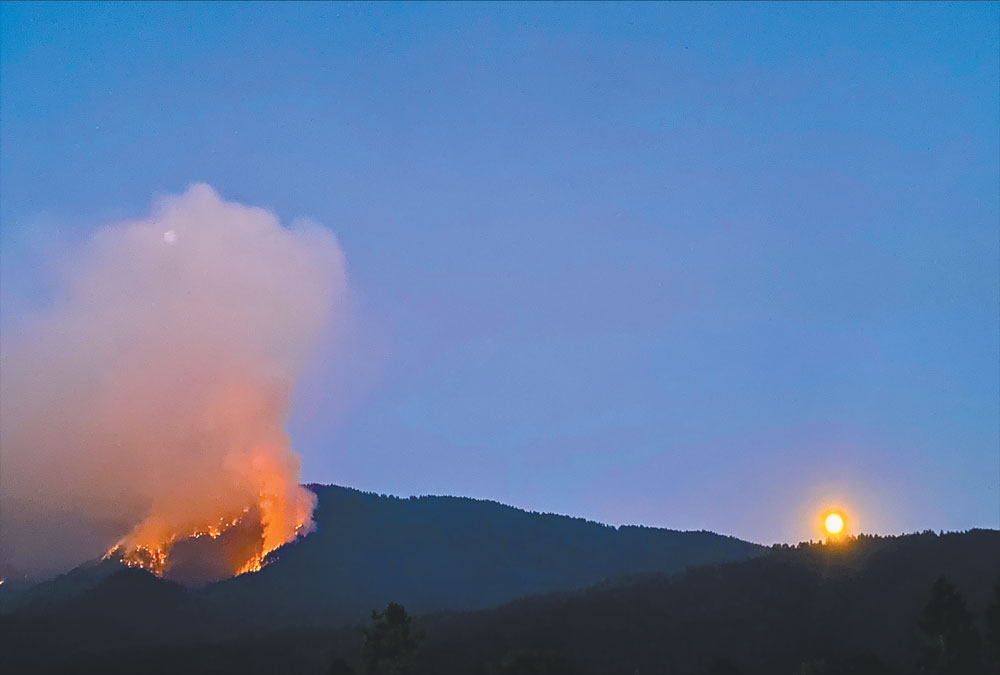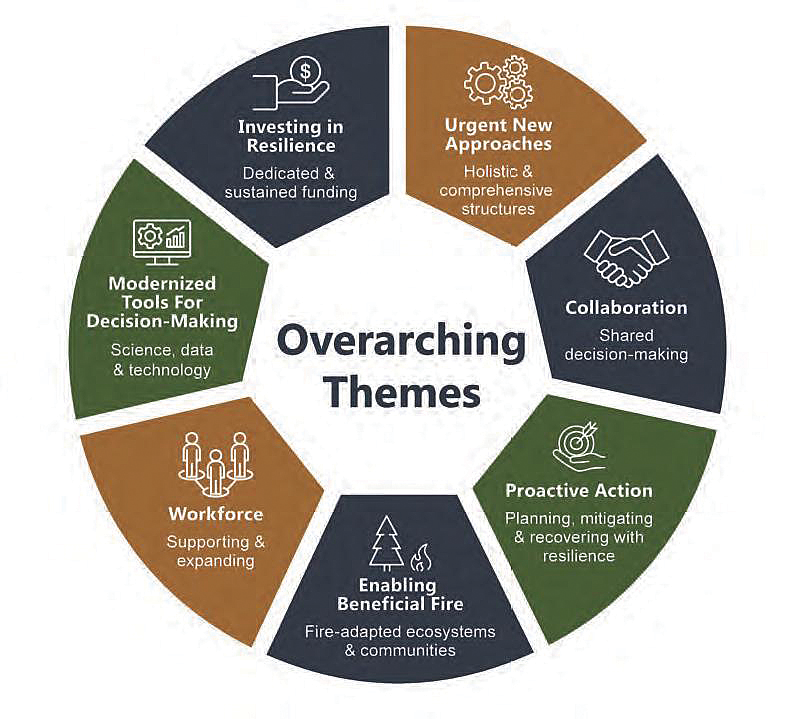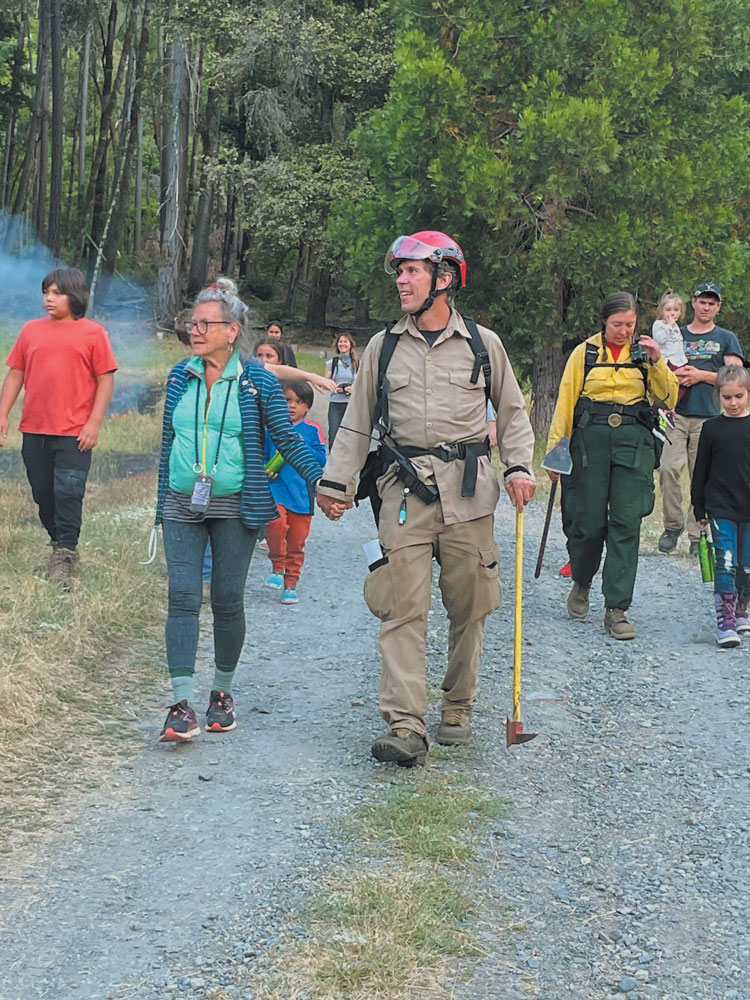Restoring Beneficial Fire in the Klamath Mountains: A Long Time Coming

By Will Harling, Mid Klamath Watershed Council
In the Klamath Mountains in California, and across the nation, 2023 was a turning point for fire. After decades of grassroots organizing underscored by ever more catastrophic wildfires that have shown the folly of attempts to take fire out of fire-dependent ecosystems, we are seeing promising gains in workforce capacity and fire policy and management. Unprecedented private, state, and federal funding is greatly expanding workforce capacity and acres treated. The Wildland Fire Mitigation and Management Commission brought 50 leaders in fire together from around the nation who unanimously agreed to 148 recommendations to Congress on how to improve our human relationship with fire. And for the first time in recent history, federal fire managers in the Six Rivers National Forest partnered with tribes and local organizations to manage the 2023 Lightning Complex for resource objectives, even under the heading of “full suppression.”
Cultural Fire workshops, programs, and cultural burns across the state are increasing the number of trained fire lighters every day, along with the number of burns.
Supporting all these advances are long-term partnerships and established trust between tribes, the local, regional, and national NGOs, and aligned staff within state and federal fire agencies. Changing fire culture has been akin to slowly turning an aircraft carrier, but after several decades we are seeing more support for greatly expanding the use of beneficial fire. For example, every year the Chief of the U.S. Forest Service writes a Letter of Intent that underscores the focus of the agency in regard to wildfire for that season. In his 2023 letter, Chief Randy Moore stated:
We will also continue to use every tool available to reduce current and future wildfire impacts and create and maintain landscape resilience, including using natural ignitions at the right time and place in collaboration with tribes, communities, and partners. …
It is my expectation that all line officers and fire leadership will use pre-season engagement planning with their state, county, and local governments, community leaders, and partners, leveraging the best science available, including the Potential Operational Delineation (PODs) program led by Research and Development. When PODs are in place, agency administrators should ensure that incident management teams use them to inform suppression strategies; when they are not, every effort should be
made to develop them in real-time as part of strategic operations.

Using this direction as a guide, the Six Rivers National Forest chose to manage the SRF Lightning Complex fires on the Orleans and Ukonom Ranger Districts for resource benefits, aerially igniting strategic ridgelines along PODs boundaries to connect four separate wildfires just north and west of the communities of Orleans and Somes Bar. Whereas wildfires in other districts in the Six Rivers NF were suppressed through direct attack, decades of community and tribal advocacy created the social license for federal fire managers to take a different approach on the Orleans/Ukonom Ranger Districts. Given recent high-severity wildfires, including the 2020 Slater Fire that burned 125,000 acres in one 24-hour period with over 70% burned at high severity, the 2023 SRF Lightning Complex created a powerful model for how wildfires could be managed in wet seasons to return fire to areas where it has been long absent.
The Suppression Debate Rages On
The supporters of continued fire-suppression policies also realize the danger to the suppression industry, which gives our military and healthcare systems competition for the title of Disaster Capitalism’s poster child. Siskiyou County Supervisor Ray Haupt, speaking up for industrial timber interests that have long profited from publicly subsidized fire suppression, recently tried to pass a County Resolution that mandated full fire-suppression response for all wildfires in the county. Previously, the County lobbied successfully to have wildfires on mixed private and industrial timber ownership managed under Unified Command, forcing the Klamath National Forest to co-manage fires with the Siskiyou Unit of CAL FIRE, who are avid supporters of full fire suppression. As fate would have it, enough people spoke up at the County Board meeting against the recent resolution, which flies in the face of common sense, science, and traditional fire knowledge, that the Board tabled the issue until its December 2023 meeting, and then indefinitely.
Despite local and industry attempts to delay the inevitable, change is afoot in the national fire policy arena. The final report of the Wildland Fire Mitigation and Management Commission, convened in 2021 by Congress to provide recommendations on solving the nation’s wildfire crisis, was released in September 2023 with 148 recommendations addressing the following overarching themes below, and in the chart below.

In addition to calling for much higher levels of engagement with all parties that are affected by how fires are managed, the Commission, through the advocacy of Tribal commission members including Bill Tripp, Executive Director for the Karuk Department of Natural Resources, was able to forward significant recommendations for elevating tribes and cultural burning at all levels of government. These include:
- Remove BIA as the overseer of tribal burn programs. Fund and allow Tribes to manage their own burn programs.
- Acknowledge cultural burning in federal law and provide mechanisms for cultural burning on public lands.
- Congress should ensure that federal agencies have the capacity and authority to enter into meaningful co-stewardship and co-management authorities with Tribes on multi-jurisdictional landscapes. Note: Not so long ago, co-management was a four-letter word within federal agencies.
- Revise the 1911 Weeks Act to include Tribes in the management and restoration of fire on equal footing with states.
- Ensure that fire mitigation and management personnel are trained in and respectful of Tribal sovereignty and cultural practices. Note: This is huge in light of the disrespectful and outright racist behavior of leadership within some Incident Management Teams on the 2023 SRF Lightning Complex.
* Note: Some of these recommendations have been paraphrased.
Together these and other recommendations provide a blueprint for a paradigm shift in how fire is managed in the United States. Commission members have been in Washington, DC meeting with legislators to advocate for these recommendations to be turned into law and policy. With bipartisan support for the Commission, there is hope this will come to pass.
The Next Generation of Fire
After 25 years of working on fire policy, many of us see clearly that change happens when there is a shared vision from the local to the national level. When I began this work, gatekeepers at multiple levels were silencing our voices, but as wildfires began to get worse and worse and our alliances grew stronger with national NGOs like The Nature Conservancy’s North American Fire Initiative and progressive state and federal fire managers, the stories of failed attempts at fire exclusion and forced cessation of Indigenous and non-agency burning reached national and international media, and policymakers began to listen in earnest. Grassroots movements are successful when they don’t forget that everyday people matter and that the change we are pushing for benefits people across all social, cultural, and economic divides. For me, this has meant focusing on engaging everyday folks in the practice of prescribed fire—in knowing fire on a deeper level in the places they live and telling these stories of hope and change.
In December 2022, I received my state certification as a California state Burn Boss (CARX). For this to even be possible, a diverse group of fire practitioners across the state organized for several years to pass legislation mandating that CAL FIRE create this program. Subsequent legislation created a prescribed fire claims fund that provides 2 million dollars in liability coverage for CARX burners and landowners involved in these burns. On July 11, 2023, I was able to lead a small six-acre grass burn where I live at Butler Flat on the Salmon River. The local Junction Elementary School students, mine and my neighbors’ kids, and other local youth (28 in total, ranging from 6 to 19 years old) were the firing team, broken into four groups. These groups were led by leaders of the Siskiyou and Humboldt PBA (a local NGO) and the Karuk Department of Natural Resources.

After 20 years of inviting youth to watch burns, having the ability to engage them in burn practices was transformative for all of us. Eric Darragh, MKWC Fire Program Director and federal Type 2 burn boss (RXB2), afterward described a moment when a seven-year-old girl was dragging a drip torch with her back to the fire, and she was about to connect her strip with another lighter and be trapped. Before he could say anything, she looked up, saw what was about to happen and did a graceful pirouette into the green and finished off the strip. In that moment, he realized the truth: that we teach fire out of our youth, that humans have an innate knowledge of fire, and that if fed, that knowledge can be restored.
We have reached a watershed moment where the dedicated work of diverse proponents of beneficial fire, led by Tribes who have held on to their relationship with fire despite nearly 200 years of persecution, has turned the political tide in California and nationally.
There is still an incredible amount of hard work to be done, and there will no doubt be setbacks along the way, but we must remember to take these moments where the change is visible to celebrate what we have accomplished together, to gather around the fire and tell stories, then get back to work!
For more information: mkwc.org
